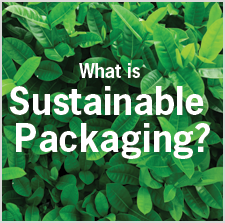What is Sustainable Packaging?
June 21, 2021
In today’s edition of the Inland Blog, we are taking a crack at answering the behemoth of a question ‘What is sustainable packaging?’. While we would love to give you a simple, easy to use definition or guidelines, it’s not that easy. The good news is, there are new technologies that are able to improve the sustainability of labels and packaging, recycling systems are evolving, and circular economies are growing! We hope that this blog can you give you some clarity on deciding what’s best for your brand and understanding what sustainable packaging is. Now, let’s get into the nitty gritty!
Defining Sustainable Packaging
When you think of sustainable labels and packaging, what comes to mind? That the package is recyclable? That it’s made from recycled material? No emissions while the package or label was being produced? That the pack is compostable? All the above? Before we dive in, let’s take a look at some buzz words that actually mean different things, but are often used interchangeably.
PCR – Post Consumer Recycled. Recycling material that has previously been used by consumers. For plastic containers, they typically get melted down into pellets, and then remelted to make PCR containers.
Post Industrial Material – When waste material in the original manufacturing process is reused to make the same material. The Sustainable Packaging Coalition gives a great example saying “When making soda cans, a roll of aluminum is cut into round pieces that are then molded into their traditional shape. Scraps from the cutting process are then melted down, rolled again, and the process continues.”
Compostable – The package or labels, including the inks, can be decomposed into soil. There are two different distinctions here, home, and industrial compostable. Home compostable means you could bury the item in your back yard, and you’ll have richer soil once the item decomposes. Industrial compostable usually means the item needs to be in a controlled environment to decompose and won’t deteriorate in your backyard.
Biodegradable – The material will breakdown into microplastics.
These types of packaging along with recyclable, reusable, and more are all considered sustainable packaging. We find this, along with some of those buzzwords, is where some of the confusion comes from when chatting about sustainable packaging. It truly means different things to different people. The important thing to remember is that all sustainable packaging has one common theme, lowering the impact we have on the Earth!
What To Do
Now that we have an idea on what the term ‘sustainable packaging’ encompasses, let’s talk about how to decide what to do. We can all agree, in a perfect world, all packaging would be made from environmentally friendly materials that’s properly recycled and reused, and that doesn’t emit emissions during the manufacturing process. We can also all agree that this option doesn’t currently exist. The good news is there are lots of new technologies and systems that you can take advantage of to start making strides towards having more sustainable packaging! Technologies like PureWash™, crystallizable shrink, down gauging materials, and E-Beam coatings are options that you can incorporate into your current labeling and packaging methods. All these technologies focus on increasing recyclability or using less materials, a step in the right direction!
It can be hard to decide what to do and where to start. Having strong relationships with your supply chain is essential! Ask for their expertise in their industry on the different options that apply to you and your brand’s labels and packaging (P.S. our LiveChat and contact us form are always open. We LOVE to talk labels and packaging). Your supply chain partners will help you determine the best fit for current state and where you can go in the future!
Circular Economy
Earlier we mentioned another hot topic in the sustainable packaging realm – circular economy. Some of you may have heard of this before, but those who haven’t, a circular economy is where the packaging is used and then re-used in a closed loop system, instead of being used once and then thrown out. If the name Loop comes to mind, you’re right on track. Loop is one of the more well-known attempts at creating a circular economy. Loop is a system where the packaging (usually stainless steel) is zero waste and designed to be reused and refilled over and over.
In the packaging space a circular economy focuses on the three Rs (you know what we’re talking about, say it with us) – Reduce, Reuse, and Recycle. The idea that you are reducing the amount of packaging you need, by refilling the container several times and reusing it, and then once the container does wear out, recycling it. These type of reusable container systems are really starting to gain traction. Many people think this is the future of sustainable packaging for several reasons. One of those is because recycling alone isn’t the answer to our packaging waste problems. In fact, even if we recycled all the plastic packaging out there, unfortunately there isn’t enough capacity or demand for recycled plastic to use it all up. Having the containers be reusable and refilled obviously saves lots of packaging from entering landfills and the ocean.
Everyone Plays a Role, Especially Consumers
Through all the sustainability conferences, articles, and research, the most important lesson we’ve learned about sustainable packaging is everyone plays a role, especially your consumers. It’s up to the raw material suppliers to produce sustainable options, the label converters to offer those materials and try new technologies, the packaging and labeling buyers need to purchase and implement them, brand owners need to educate consumers, consumers need to understand if a package is sustainable and if there are any special requirements (like how to recycle them), and recycling streams need to evolve to handle these new options. Whew! That’s a lot of people.
You can do everything right in terms of sustainable packaging, but consumers still need to understand what to do at the end of the product’s life. Do they take it to a store and refill the container? Do they need to remove the label to recycle it? Can they recycle it at home, or does it need to be taken to a special facility? Making it as easy as you can for consumers to understand, only increase the odds that the package ends up in the right place, and not just the garbage.
If you’re starting to invest in having more sustainable packaging, it’s worth it to educate your consumers. If they don’t understand what to do, it can jeopardize your efforts to minimize the impact your packaging has on the Earth. Some brands add perforations to their label so it can be easily removed from the container. Others have instructions on how to recycle the product or where you can bring it to be refilled. There are many other ways to educate your consumers like social media, advertising, your website, QR codes and more!
The biggest take away we want to leave you with, is there isn’t only one option for sustainable packaging and there are usually tradeoffs for it. If you want to use a highly recycled container like glass, then you’ll have to have more trucks of your product for shipping, creating higher emissions. The Flexible Packaging Association explains that one truckload of unfilled flexible packaging has the same number of containers as 26 truckloads of unfilled glass jars. While you’re creating less waste with the glass jars, you’ll be producing more emissions. With flexible packaging you’re creating less emissions during shipping, but not all flexible packaging is recyclable, which can create more waste. There are a few win-win situations like downgauging materials, which uses less material and lowers emissions because more material can fit on one roll, meaning fewer trucks needed to ship your labels.
We hope that you have a better understanding of the answer to ‘What is sustainable packaging?’. It’s a complicated topic filled with buzz words and a lot of new technology. As we mentioned above, we are passionate about labels and packaging and would love to hear from you. In an effort to be more transparent in our sustainability efforts, you can check out our 2020 Sustainability Report to see everything we did last year to take steps in making less of an impact on Earth!



